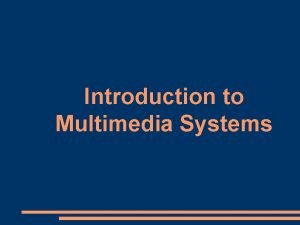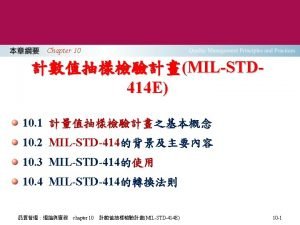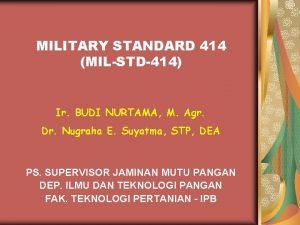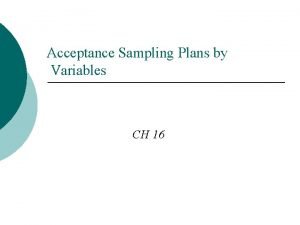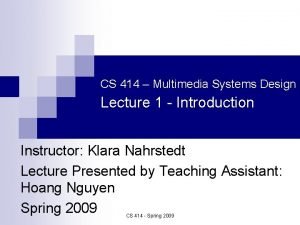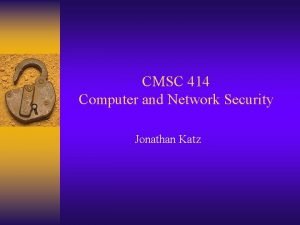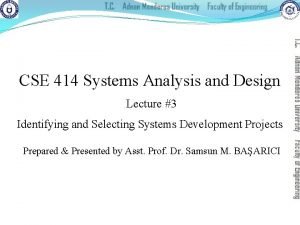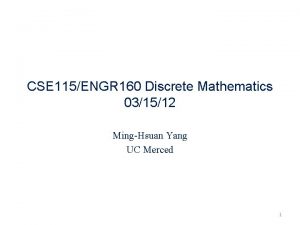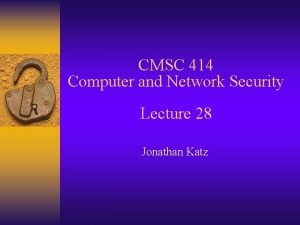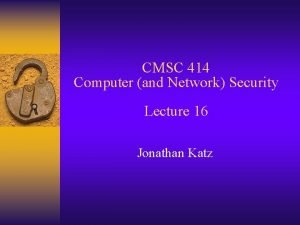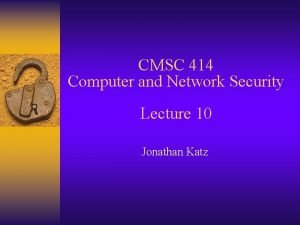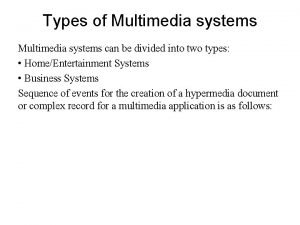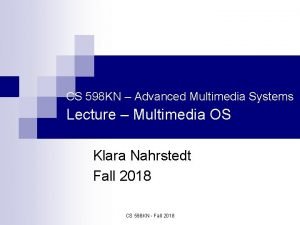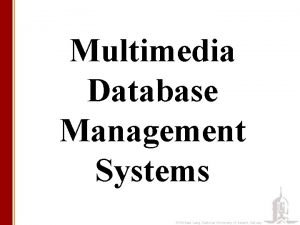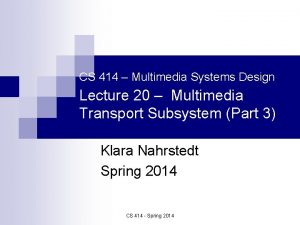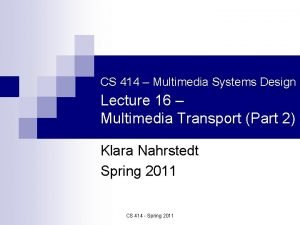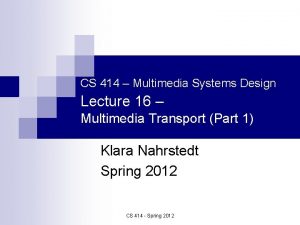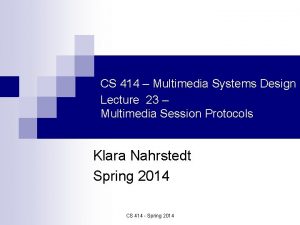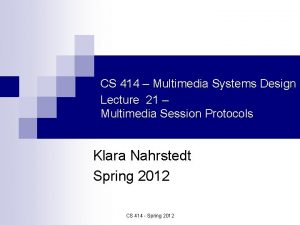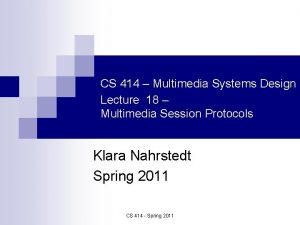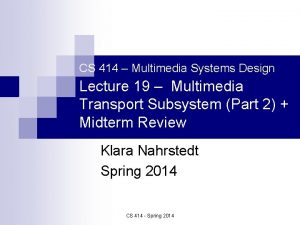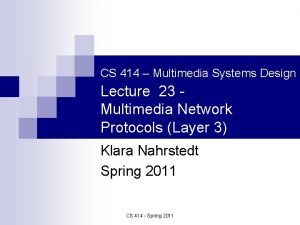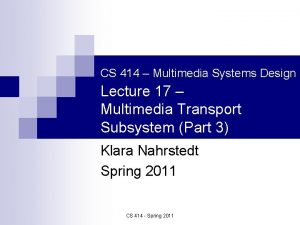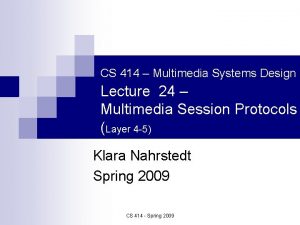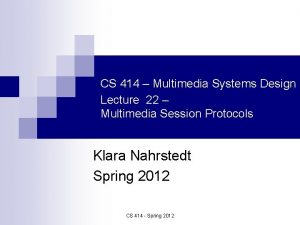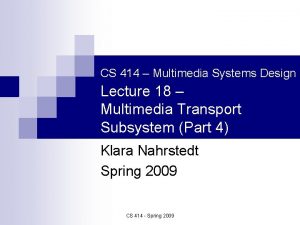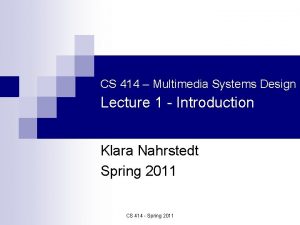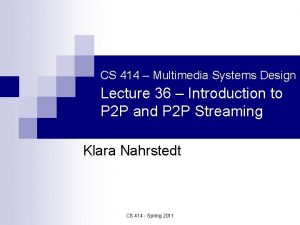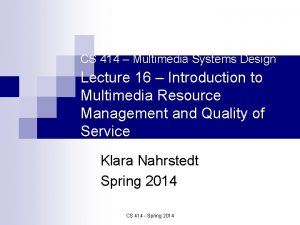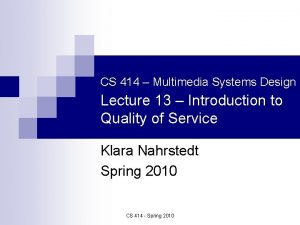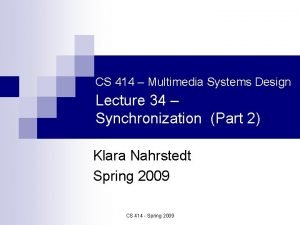CS 414 Multimedia Systems Design Lecture 14 Introduction
































- Slides: 32

CS 414 – Multimedia Systems Design Lecture 14 – Introduction to Multimedia Resource Management Klara Nahrstedt Spring 2012 CS 414 - Spring 2012

Administrative Reading: “Multimedia Systems”, Steinmetz and Nahrstedt, Springer 2004, Chapter 2 n HW 1 posted on Wednesday, February 22. n ¨ HW 1 due on Thursday, March 1. CS 414 - Spring 2012

Outline AV Requirements - Real-time n AV Requirements on Multimedia Communication and Operating Systems n Resource management n ¨ Resources ¨ Quality of Service (Qo. S) Concept ¨ Operations CS 414 - Spring 2012

Integrating Aspects of Multimedia Image/Video Capture Audio/Video Perception/ Playback Audio/Video Presentation Playback Image/Video Information Representation Transmission Audio Capture Transmission Compression Processing Audio Information Representation Media Server Storage CS 414 - Spring 2012 A/V Playback

Integrating Aspects of Multimedia Image/Video Capture Audio/Video Perception/ Playback Audio/Video Presentation Playback Image/Video Information Representation Transmission Audio Capture Transmission Compression Processing Audio Information Representation Media Server Storage CS 414 - Spring 2012 A/V Playback

Integrating Aspects of Multimedia Image/Video Capture Audio/Video Perception/ Playback Audio/Video Presentation Playback Image/Video Information Representation Transmission Audio Capture Transmission Compression Processing Audio Information Representation Media Server Storage CS 414 - Spring 2012 A/V Playback

For Next Four Weeks we will cover Transmission/Networks of Multimedia Image/Video Capture Audio/Video Perception/ Playback Audio/Video Presentation Playback Image/Video Information Representation Transmission Audio Capture Transmission Compression Processing Audio Information Representation Media Server Storage CS 414 - Spring 2012 A/V Playback

Multimedia System/Network Sender/Server MM Application OS/Distributed Systems/Network Receiver/Client Capture AV Code AV Display AV Decode AV Stream AV, Sync AV, Schedule AV, Queue/Buffer AV, Shape AV, Manage AV, Route AV, Retrieve AV, Pre-fetch/Cache AV, Record AV Network CS 414 - Spring 2012 MM Application OS/DS/Network

AV Requirements: Real-Time and Deadlines n Real-time system – system in which correctness of computation depends not only on obtaining the right results, but also providing them on time ¨ Examples: control of temperature in a chemical plant; control of a flight simulator n Deadline – represents the latest acceptable time for the result delivery ¨ Soft deadlines versus hard deadlines CS 414 - Spring 2012

AV Requirements: Real-Time and Multimedia n Difference between RT requirements for traditional RT systems and Multimedia systems ¨ Soft deadlines versus hard deadlines ¨ Periodic behavior versus random behavior ¨ Bandwidth requirements CS 414 - Spring 2012

Layered Partition of Multimedia Systems with respect to Required Resources and Individual Services CS 414 - Spring 2012

AV Requirements on MM Systems and Networks Transport system – guaranteed delivery with respect to metrics such as delay, reliability, bandwidth requirements n OS process management – real-time processing of continuous data, communication and synchronization between processes/ threads n CS 414 - Spring 2012

AV Requirements on MM Systems and Networks (2) Memory/Buffer management – guaranteed timing delay and efficient data manipulation n File system/Media Servers – transparent and guaranteed continuous retrieval of audio/video n Device management – integration of audio and video n CS 414 - Spring 2012

Result of AV Requirements n Need Resource Management to coordinate ¨ Transport/Network Resources, ¨ CPU/OS Resources ¨ Memory/Buffer Resources ¨ Storage/Disk Resources ¨ Device Resources CS 414 - Spring 2012

Resource Management (Why do we need resource management? ) Limited capacity in digital distributed systems despite data compression and usage of new technologies n Need adherence for processing of continuous data by every hardware and software component along the data path n Competition for resources exist in an integrated multimedia system n CS 414 - Spring 2012

Window of Resources Requirements Interactive HDTV-quality multi-view video Sufficient To abundant insufficient HDTV High-quality Audio sufficient Insufficient Sufficient But scarce Sufficient but Scarce to Sufficient insufficient abundant insufficient Sufficient Network File access Sufficient But scarce 1980 1990 2000 CS 414 - Spring 2012 abundant 2010 2020 Hardware support

Quality of Service (How to parameterize services? ) n To manage resources, we need services over resources ¨ n to schedule AV data, to shape access for AV data, to process AV data, to move AV data, etc. Multimedia systems consist of set of AV-specific services Processing (media-related) services: retrieve audio/video, record video/audio, compress audio/video, fast forward video, rewind video ¨ Transport (network) services: Stream video, fast forward video, rewind video ¨ n To provide multimedia services, services get parameterized with quality levels called Quality of Service CS 414 - Spring 2012

Examples of A/V Qo. S Parameters n Qo. S for Audio service: n n n Sample rate – 8000 samples/second (8 KHz), 44. 1 KHz Sample resolution – 8 bits per sample, 16 bits per sample Qo. S for Video service: n n n Video frame rate – 25 frames per second, 30 frames per second Frame Period – 40 ms, 30 ms, 25 ms, … Frame resolution – 320 x 240 pixels, 640 x 480 pixels, 1920 x 1080 pixels, … Pixel resolution – 24 bits per pixel, 8 bits per pixel Frame size – 64 KB Compression rate – 8: 1 CS 414 - Spring 2012

Examples of Network Qo. S n Qo. S for network service: n Throughput – Number of bits per second e. g. , 100 Mbps (Ethernet throughput) – level 1 ¨ e. g. , 10 Mbps (Wi. Fi throughput) – level 2 ¨ e. g. , 128 kbps (ISDN throughput) – level 3 ¨ n Connection setup time – time how long it take to connect the sender and receiver ¨ n e. g. , 50 ms, 10 ms, … End-to-End Delay – time interval from the time packet is sent from the sender until the time it is received at the receiver (Treceive – Tsend) ¨ e. g. , 80 ms, 100 ms, 160 ms CS 414 - Spring 2012

Layered Model for Qo. S Quality of Experience Quality of Service CS 414 - Spring 2012

Application Qo. S Parameters CS 414 - Spring 2012

System Qo. S Parameters CS 414 - Spring 2012

Network Qo. S Parameters CS 414 - Spring 2012

Qo. S Classes n Guaranteed Service Class ¨ Qo. S guarantees are provided based on deterministic and statistical Qo. S parameters n Predictive Service Class ¨ Qo. S parameter values are estimated and based on the past behavior of the service n Best Effort Service Class ¨ There are no guarantees or only partial guarantees are provided CS 414 - Spring 2012

Qo. S Classes (cont. ) Qo. S Class determines: (a) reliability of offered Qo. S, (b) utilization of resources CS 414 - Spring 2012

Deterministic Qo. S Parameters Single Value: Qo. S 1 – average (Qo. Save), contractual value, threshold value, target value • • • Throughput – 10 Mbps Pair Value: <Qo. S 1, Qo. S 2> with Qo. S 1 – required value; Qo. S 2 – desired value <Qo. Savg, Qo. Speak>; <Qo. Smin, Qo. Smax> • Throughput - <8, 12> Mbps CS 414 - Spring 2012

Deterministic Qo. S Parameter Values n Triple of Values <Qo. S 1, Qo. S 2, Qo. S 3> ¨ Qo. S 1 – best value ¨ Qo. S 2 – average value ¨ Qo. S 3 – worst value n Example: ¨ <Qo. Speak, Qo. Savg, Qo. Smin>, where Qo. S is network bandwidth ¨ Throughput <12, 10, 8> Mbps CS 414 - Spring 2012

Guaranteed Qo. S n n We need to provide 100% guarantees for Qo. S values (hard guarantees) or very close to 100% (soft guarantees) Current Qo. S calculation and resource allocation are based on: 1. 2. Hard upper bounds for imposed workloads Worst case assumptions about system behavior Advantages: Qo. S guarantees are satisfied even in the worst case (high reliability in guarantees) Disadvantage: Over-reservation of resources, hence needless rejection of requests CS 414 - Spring 2012

Predictive Qo. S Parameters n We utilize Qo. S values (Qo. S 1, . . Qo. Si) and compute average ¨ Qo. Sbound n We utilize Qo. S values (Qo. S 1, , Qo. Si) and compute maximum value ¨ Qo. SK n step at K>i is Qo. SK = 1/i*∑j. Qo. Sj = max j=1, …i (Qo. Sj) We utilize Qo. S values (Qo. S 1, , Qo. Si) and compute minimum value ¨ Qo. SK = min j=1, …i (Qo. Sj) CS 414 - Spring 2012

Best Effort Qo. S No Qo. S bounds or possible very weak Qo. S bounds n Advantages: resource capacities can be statistically multiplexed, hence more processing requests can be granted n Disadvantages: Qo. S may be temporally violated n CS 414 - Spring 2012

Relation between Qo. S and Resources Reservation Admission Translation, Scaling, Negotiation Scheduling, Rate Control Flow Control, Congestion Control, Adaptation CS 414 - Spring 2012

Conclusion Qo. S – an important concept in multimedia systems n Very different types of Qo. S parameters and values n Important relation between Qo. S and Resources n Need to understand operations on Qo. S and their impact on resource management n CS 414 - Spring 2012
 History of multimedia
History of multimedia 01:640:244 lecture notes - lecture 15: plat, idah, farad
01:640:244 lecture notes - lecture 15: plat, idah, farad Multimedia becomes interactive multimedia when
Multimedia becomes interactive multimedia when Linear multimedia
Linear multimedia Csc 253
Csc 253 Esa multimedia.esa.int./multimedia/virtual-tour-iss
Esa multimedia.esa.int./multimedia/virtual-tour-iss 0 414
0 414 Mil std 414
Mil std 414 Mil std 414
Mil std 414 414 climate change
414 climate change Cs 414
Cs 414 Cmsc414 umd
Cmsc414 umd Cse 414
Cse 414 Gcd of 414 and 662
Gcd of 414 and 662 Cmsc 414
Cmsc 414 Cmsc 414
Cmsc 414 Cmsc 414
Cmsc 414 Introduction to systems analysis and design
Introduction to systems analysis and design Advanced operating system notes
Advanced operating system notes Articulators
Articulators Lecture sound systems
Lecture sound systems Introduction to biochemistry lecture notes
Introduction to biochemistry lecture notes Introduction to psychology lecture
Introduction to psychology lecture Introduction to algorithms lecture notes
Introduction to algorithms lecture notes Types of multimedia system
Types of multimedia system Cs598
Cs598 Multimedia dbms
Multimedia dbms Anchorage length eurocode
Anchorage length eurocode Urban design lecture
Urban design lecture Elements and principles of interior design ppt
Elements and principles of interior design ppt Lecture hall background
Lecture hall background Game design lecture
Game design lecture Computer-aided drug design lecture notes
Computer-aided drug design lecture notes
